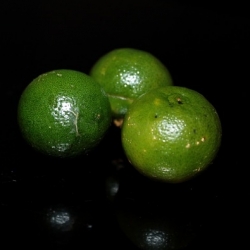Kalamansi
 What is Kalamansi?
What is Kalamansi?
Kalamansi is a citrofortunella, which means that it's a hybrid between the gene citrus and the kumquat that belongs to Fortunella. The citrus in this case is most probably the mandarin orange. Kalamansi is most commonly used as an ornament tree rather than a fruit, however it is edible as well. It is known throughout the world with different names like Calamondin, calamandarin, Philippine lime, musk orange and acid orange among many other names.
Properties of Kalamansi
Kalamansi trees are small, bushy and can grow up to a height of 20 feet. Tiny spines can be observed on the branches of growing kalamansi trees, which contain remarkable orange scented blossoms which become small orange fruits which are about 1 inch in diameter and resemble a tangerine. The fruit is without seeds and is acidic. Kalamansi blossoms in spring and tastes bitter similar to a lemon. The skin of a kalamansi is thin and can simply be separated from the soft juicy flesh without much effort. Juice can be squeezed by crushing the whole fruit and collecting the nectar in a bowl.
It takes about two years for a seedling of a kalamansi tree to produce fruits. Flowers appear at the same time as the fruits do. One kalamansi fruit can contain up to 12 calories with a very low fat content. Potassium, fibre, calcium, water and carbohydrates are also present in the fruit which makes it a healthy food to consume as well.
Health benefits of Kalamansi
Kalamansi is used as a culinary art. The fruits are mostly used to flavour food and drinks. It is also frozen and used as ice cubes in drinks and beverages. In the United States it is used for seasoning of fish, pork and fowl. However, it is Kalamansi's numerous health benefits that make it such an amazing fruit. It boosts the production of collagen in the body as it contains ascorbic acid and Vitamin C. It is because of this reason it is a very popular skin ingredient as well.
Consuming Kalamansi is also known to keeps away colds and flu. Since the fruit has a very low fat content, it can be consumed to reduce weight as well. Dieticians actually recommend a glass of kalamansi juice before a meal because it helps the person to avoid eating too much food. Vitamin C in the fruit prevents tooth decay and eliminates plaques and stains. Its benefits are not limited for consumption only though; dandruff and flakes common in males can be treated by rubbing kalamansi directly on the scalp.
Where can I buy Kalamansi?
Kalamansi was originally found in China according to some sources. However its cultivation has spread to Southeast Asia, Hawaii, India, Central and North America and other places, which means you can buy kalamansi from a store nearby you. In America it is mostly grown as an ornamental plant in the backyards, in pots and container gardens, so its availability is not really something you'll have to search for.
Keep Reading...
Aloe Vera - Oregano - Arrow Root - Sambobg - Kalamansi - Malunggay - Mint - - Guava - Coconut Water - Banaba - Guyabano - Ginger - Lemongrass - Tawas